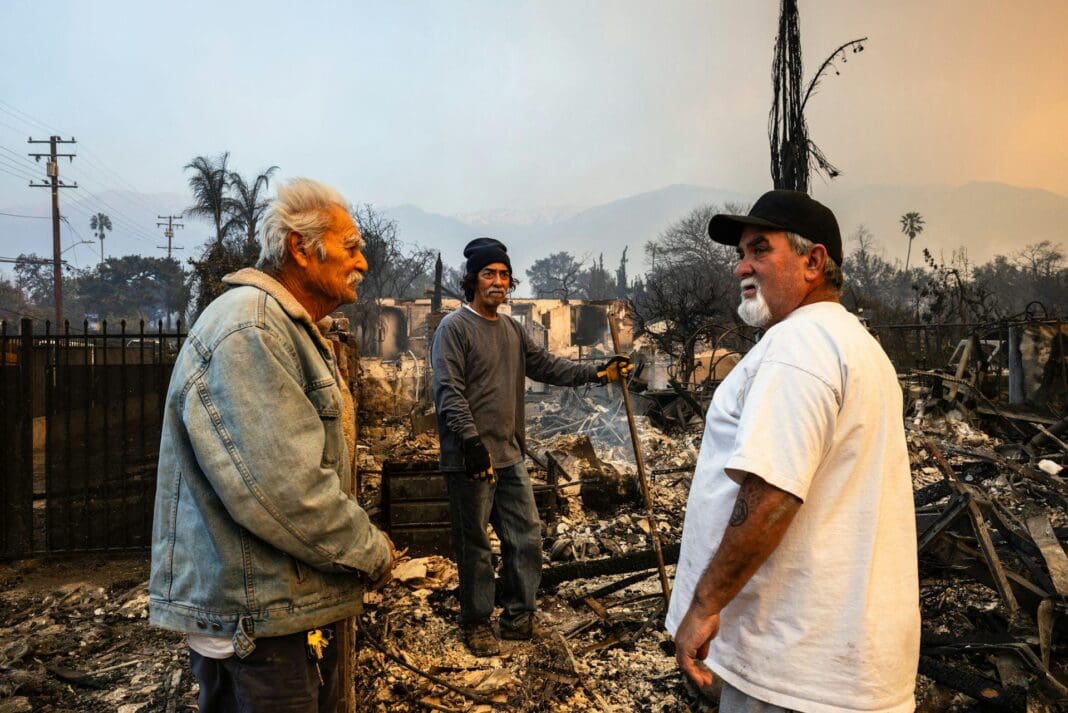The dramatic images of wealthy neighborhoods burning during the January 2025 Los Angeles wildfires captured global attention, but the damage was much more widespread. Many working-class families lost their homes, businesses and jobs. In all, more than 16,000 structures – most of them homes – were destroyed, leaving thousands of people displaced.
The shock of this catastrophic loss has been reverberating across Southern California, driving up demand for rental homes and prices in an already unaffordable and competitive housing market. Many residents now face rebuilding costs that are expected to skyrocket.
Climate-related disasters like this often have deep roots in policies and practices that overlook growing risks. In the Los Angeles area, those risks are now impossible to ignore.
As the region starts to recover, communities have an opportunity to rebuild in better ways that can protect neighborhoods against a riskier future – but at the same time don’t price out low-income residents.
Research shows that low-income residents struggle the most during and after a disaster. Disaster assistance also tends to benefit the wealthy, who may have more time and resources to navigate the paperwork and process. This can have long-term effects on inequality in a community. In Los Angeles County, where one-third of even moderate-income households spend at least half their income on housing, many residents may simply be unable to recover.
My research at the University of San Diego focuses on managing risk in the face of climate change. I see several ways to design solutions that help low- and moderate-income residents recover while building a safer community for the future.
Before a disaster, communities trying to adapt to climate change often prioritize protecting high-risk, high-value property, such as a beachfront or hillside neighborhood with wealthy homes. My own research also shows a trend toward incremental climate adaptations that don’t disturb the status quo too much and, as a result, leave many risks unaddressed.
Climate risks are often underestimated, in part because of policy limitations and a political reluctance to consider unpopular solutions, such as restricting where people can build. Yet, disasters once considered unimaginable, such as the Los Angeles wildfires, are occurring with increasing frequency.
Making communities safer from these risks requires communitywide efforts. And that can mean making difficult decisions.
Policy changes, such as updating zoning laws to prevent rebuilding in highly vulnerable areas, can avoid costly damage in the future. So can not building in risky areas in the first place.
California already has some of the strictest wildfire-prevention codes in the country, but the same rules for new homes don’t apply to older homes. Communities can invest in programs to help these property owners retrofit their homes by offering grants or incentives to remove highly flammable landscaping or to “harden” existing homes to make them less vulnerable to burning.
Research shows that resilience efforts can spur “climate gentrification,” or displacement due to increases in property values. So, focusing on affordability in resilience efforts is important. For long-term affordability and resilience, governments can collaborate with communities to develop strategies such as supporting Community Land Trusts through grants, low-interest loans or land transfers; implementing zoning reforms to enable higher-density, climate-resilient affordable housing; and incentivizing green infrastructure to strengthen community resilience.
In some cases, communities may have to considered managed retreat – moving people out of high-risk areas – but with adequate compensation and support for displaced residents to ensure that they can rebuild their lives elsewhere.
Insurance rates can also encourage residents and communities to lower their risks. Yet in many places, insurance policies have instead obscured the risks, leaving homeowners less aware of how vulnerable their property may be.
For years, insurers underpriced wildfire risk, driven by market competition. California policies also capped the premiums they could charge. As fire damage and rebuilding costs soared in recent years, insurers unwilling to shoulder more of the risk themselves pulled out of the state. That left countless Californians uninsured and hundreds of thousands reliant on the state-run insurance known as the FAIR Plan. The plan imposes caps on payouts and is now struggling to stay solvent, resulting in higher costs that insurers are expected to pass on to consumers.

Insurance reforms could help reduce the financial burden on vulnerable populations while also lowering overall risk. To achieve this, the reforms could incentivize building more resilient homes in less risky areas.
As seen with the LA fires, what your neighbor does matters. Reducing fire risk in each home can make entire neighborhoods safer. Insurers can provide a road map for how to reduce those risks, while state and local governments can provide assistance to retrofit homes and help ensure that insurance premiums remain affordable.
There are also innovative approaches to fund resilience efforts that can include insurers. One example is New York’s Climate Change Superfund Act, which requires fossil fuel companies to finance climate adaptation efforts.
When disasters strike, local groups and neighbors play critical roles in stabilizing neighborhoods. But residents also need more specialized help to find housing and apply for disaster aid.
Building resilience hubs in communities could help support residents before, during and after disasters.
The resilience hub in the Boyle Heights neighborhood of Los Angeles provides one model for what these spaces can achieve. It’s anchored in a community arts center with solar power and backup energy storage. Residents can drop in to cool down during heat waves or charge their phones during power outages. It also hosts community classes, including in disaster preparedness.
During and after a disaster, resilience hubs can serve as central organizing points. They can provide crucial information, resources and assistance with completing paperwork to access aid. Having access to skilled help in navigating what can be a complicated, time-consuming process is often critical, particularly for people who aren’t native English speakers.
Getting assistance is also often critical for displaced renters, who may have little certainty about when or if they will be able to return to their homes. Understanding their legal rights can be confusing, and rising costs as rental housing is rebuilt can price them out of the market.
Research shows that building a supportive community can provide a crucial social safety net when dealing with disasters and also boost the community’s social and economic well-being.
The catastrophic LA wildfires were a powerful reminder that governments and communities need to think carefully about the risks they face and the role policies may play as they learn to live with greater fire risk.
Building a resilient future in a warming world will require bold, innovative and collective strategies that support communities while advancing equitable solutions.
This article is republished from The Conversation, a nonprofit, independent news organization bringing you facts and trustworthy analysis to help you make sense of our complex world. It was written by: Nichole Wissman, University of San Diego
Read more: How America courted increasingly destructive wildfires − and what that means for protecting homes today ‘Managed retreat’ done right can reinvent cities so they’re better for everyone – and avoid harm from flooding, heat and fires LA fires: Why fast-moving wildfires and those started by human activities are more destructive and harder to contain
Nichole Wissman does not work for, consult, own shares in or receive funding from any company or organization that would benefit from this article, and has disclosed no relevant affiliations beyond their academic appointment.














